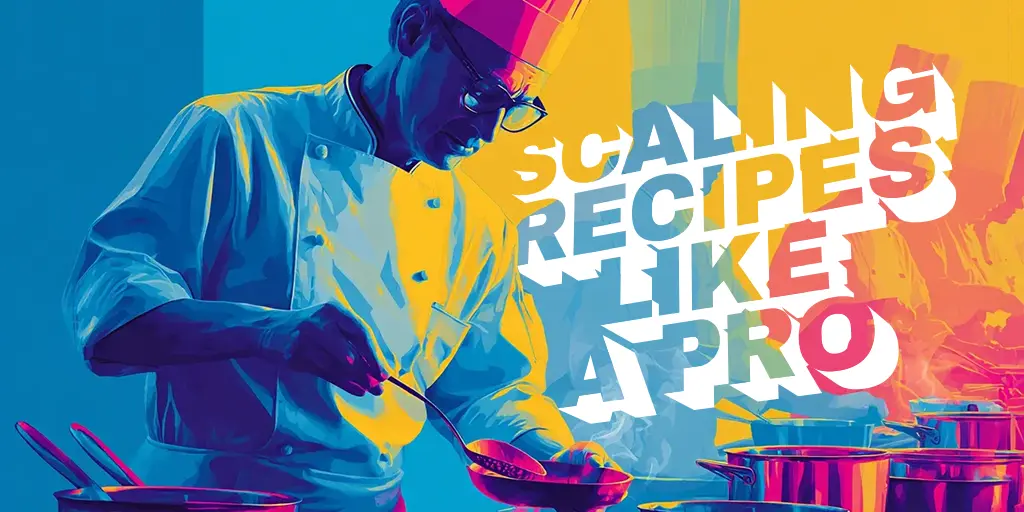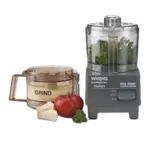
Scaling Recipes Like a Pro: A Chef’s Guide to Cooking for a Crowd
- Why Scaling Recipes Matters in Professional Kitchens
- How to Scale a Recipe: The Basic Formula
- Use a Recipe Scaling Calculator for Speed & Precision
- Scaling Up vs. Scaling Down a Recipe
- Ingredient Behavior at Scale: What Changes?
- Chef Strategies for Cooking for a Crowd
- Portion Control: The Secret to Profit and Consistency
- Tools to Help You Scale Like a Pro
- Real-World Example: Scaling Chicken Marsala for 100 Guests
- Buffet vs. Plated Events: Scaling Implications
- Essential Restaurant Equipment for Large-Scale Cooking
Whether you're catering a wedding for 150 guests or preparing a special menu for a corporate event, knowing how to scale recipes accurately is a must-have skill in a chef’s toolkit. Mistakes in conversion can lead to lost profits, inconsistent flavor, or even service disasters. This guide is tailored for chefs managing high-volume production — breaking down both the art and science of cooking for a crowd.
Why Scaling Recipes Matters in Professional Kitchens
When working events or managing chefs catering operations, you rarely deal with single-portion recipes. You need to scale up recipes to feed dozens or hundreds of people without compromising consistency or quality.
More importantly, when portions, cost per plate, and ingredient waste matter — accuracy becomes essential. This is where having a structured approach, or even using a recipe scaling calculator, can make all the difference.
How to Scale a Recipe: The Basic Formula
To properly scale a recipe, you’ll need to multiply each ingredient by the scaling factor. Here's the basic formula:
(New number of servings ÷ Original number of servings) = Scaling Factor
For example, if your original recipe serves 10 and you need to serve 150:
150 ÷ 10 = 15 (Scaling Factor)
Every ingredient in the original recipe gets multiplied by 15.
💡 Pro tip: Always convert to weight (grams, ounces, pounds) instead of using volume (cups, tablespoons) when scaling. Weight provides greater consistency at large volumes.
Use a Recipe Scaling Calculator for Speed & Precision
While manual calculations work, a recipe scaling calculator saves time and reduces human error — especially in high-pressure prep environments. These tools allow you to:
- Scale up or scale down a recipe
- Maintain accurate ratios
- Quickly recalculate yields
Some professional catering kitchens even integrate these calculators into prep sheets or kitchen display systems (KDS).
If you're managing multiple events with different guest counts, a scalable system can also help balance prep time, storage needs, and ingredient ordering.
Scaling Up vs. Scaling Down a Recipe
While many chefs focus on increasing portions, knowing how to reduce a recipe or scale down a recipe is just as valuable — especially during testing and R&D phases.
How to Scale Down a Recipe:
- Divide ingredients using the same formula (e.g., reduce a 10-portion recipe to 2).
- Be cautious with spices, leavening agents, and liquids — some don’t scale linearly.
- Round quantities to kitchen-friendly measurements (e.g., ⅓ of an egg = use whole egg with adjusted volume).
Chefs often test dishes in small batches before approving them for service. Scaling down allows you to fine-tune flavor and texture before you commit to prepping 100 portions.
Ingredient Behavior at Scale: What Changes?
Scaling isn’t just about multiplying numbers. As volumes grow, ingredient behavior can change — especially in these areas:
1. Sauces and Reductions
Larger volumes may not reduce at the same rate. Keep an eye on water evaporation and flavor concentration. Adjust cooking time, not just quantity.
2. Emulsions
Scaling vinaigrettes, hollandaise, or aioli can be tricky. The balance of fat-to-liquid may shift, leading to breaks or separation. Scale these in smaller batches and combine later.
3. Seasonings
Salt and acid tend to amplify at scale. Start at 75–80% of the scaled amount and adjust during the final stages of cooking.
4. Heat Distribution
Oven and pan capacities affect how evenly food cooks. When cooking for a crowd, be aware of hot spots and batch rotations.
Chef Strategies for Cooking for a Crowd
Scaling is one part of the puzzle. When executing catering recipes or event menus, planning and workflow become just as important. Here are some tried-and-true strategies:
1. Build a Master Prep Sheet
- Include scaled weights, prep times, assigned cooks, and equipment needs.
- Break prep into daily/shift timelines to reduce last-minute stress.
2. Do a Test Run
- Test scaled versions of tricky components (like sauces or desserts) in advance.
- Use this to adjust seasoning and texture before full production.
3. Batch Cooking
- Cook components in manageable batches to maintain consistency.
- Label and date each batch — especially for cold items or sauces.
4. Cross-Utilize Ingredients
- Design your catering recipes around overlapping mise en place.
- Fewer ingredients = less margin for prep error.
Portion Control: The Secret to Profit and Consistency
When cooking at scale, portion control is key to profitability and plate consistency. Here's how to keep things under control:
- Use portioning tools: ladles, scoops, ramekins, or pre-weighed bags.
- Standardize yields (e.g., 3 oz chicken per taco, 2 oz of dressing per salad).
- Educate line cooks on the cost of over-portioning — a few grams adds up fast.
Tools to Help You Scale Like a Pro
Equipping your kitchen with the right tools makes scaling easier and faster:
- Digital scales (down to the gram)
- Commercial food processors for consistent chopping/purees
- Tilting skillets and steam kettles for high-volume cooking
- Labeling systems for batch tracking
- Prep charts & calculators (Google Sheets, Excel, or kitchen-specific software)
Avoid These Common Scaling Mistakes
Even experienced chefs can slip up when cooking for large groups. Watch for:
❌ Blindly scaling spices – Over-seasoning is the #1 mistake
❌ Not adjusting cook times – Bigger doesn’t always mean longer
❌ Failing to test final yield – Especially for protein shrinkage and starch absorption
❌ Not planning plating flow – You can’t serve 200 plates hot without a solid system
Real-World Example: Scaling Chicken Marsala for 100 Guests
Let’s say your original Chicken Marsala recipe serves 10 people. You need to prepare it for a banquet of 100. First, calculate the scaling factor:
100 ÷ 10 = 10
Now, multiply all ingredients by 10. If your original recipe calls for:
- 3 lbs chicken breasts → Use 30 lbs
- 2 cups Marsala wine → Use 20 cups (or 1.25 gallons)
- 1 lb mushrooms → Use 10 lbs
Be aware that a full 30-lb batch might not fit in a single pan or skillet. Consider cooking in 5–6 batches to ensure even browning, proper sauce reduction, and manageable handling. This allows for quality control across each set while preserving consistency.
Buffet vs. Plated Events: Scaling Implications
How you serve the meal affects how you scale it. For buffets, portion sizes often vary depending on guest appetite. Plan a 10–15% buffer to prevent running short. For plated events, portions are more controlled — meaning tighter margins and more exact scaling.
Chefs catering buffets should also be ready for second helpings and unpredictable flow. Use chafing dishes or hot holding boxes to manage batch replenishment while minimizing waste. For plated dinners, precise portioning ensures faster plating and more consistent guest experience.
Essential Restaurant Equipment for Large-Scale Cooking
When you're scaling recipes for banquets or catering events, your commercial kitchen equipment becomes critical. Relying on home-style gear simply won't cut it. High-volume kitchens benefit from tilting skillets, steam-jacketed kettles, and combi ovens, which allow chefs to cook large batches evenly and efficiently. Blast chillers are essential for cooling food quickly during prep-ahead service, while commercial mixers and food processors save hours of manual labor when prepping sauces, dough, or emulsions. Investing in the right equipment ensures speed, consistency, and food safety — all non-negotiables when cooking for a crowd.
Final Thoughts: Scaling Recipes Is a Skill Every Chef Needs
Knowing how to scale a recipe accurately — whether you’re cooking for 10 or 200 — separates the amateurs from the professionals. For chefs catering events or running high-volume kitchens, mastering this process is essential for quality, consistency, and profitability.
With the right systems, tools, and planning strategies — plus a little help from a scale up recipe calculator — you can take your event cooking to the next level.
Quick Reference: Chef’s Scaling Checklist
- ✅ Use weight-based measurements
- ✅ Test and adjust for large-batch behavior
- ✅ Apply portion control tools
- ✅ Use a recipe scaling calculator for speed
• • ✅ Always test in small and large batches before service



